External Hard Drives |
Previous  Next Next |
Last Updated: May 13, 2008
December 12 Update:
Western Digital Passport (2.5 inch drives) and Western Digital MyBook (3.5 inch drives) are still the most popular according to PriceGrabber and NewEgg.
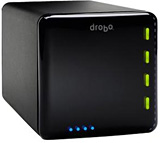 |
Today's Best Choice - Video Editors and Photography EnthusiastsThe Drobo is marketed as the world's first data robot. You can add and subtract up to four, 3.5 inch hard drives without loosing data. Watch the video demonstration and see 12 hours of work completed in seconds. Drobo is an empty box. You add the hard drive(s) of any size and any speed. It takes care of the rest. It's not the fastest drive available, but it's simple to use. Read a review from owners at NewEgg, PC Magazine (June 2007). Buy it for $470. |
||||||||||||||||||||||||||||||||||||

 |
Today's Best Choice - Desktop up to 2TBThe Western Digital My Book series hard drives are popular and inexpensive. Different models serve different needs.
|
||||||||||||||||||||||||||||||||||||
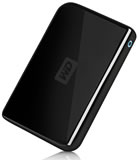
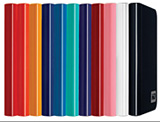 |
Today's Best Choice - MobileThe Passport Portable Drives offer a near-pocket sized drive without the power pack. It gets its power from the USB port instead. It comes with synchronization and encryption software, but does not advertise a carrying case. However, my 250GB model from Costco came with a neoprene case. There are 11 different colors to suit your personality. Buy the 160GB version for $85 ($0.53/GB, 5400rpm, USB 2.0) Buy the 250GB version for $105 ($0.42/GB, 5400rpm, USB 2.0) Buy the 320GB version for $135 ($0.42/GB, 5400rpm, USB 2.0) |
||||||||||||||||||||||||||||||||||||
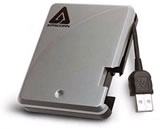 |
Today's Best Choice - Shirt Pocket SizeThe Aegis Mini 1.8 Inch USB Ultra Portable Hard Drive is one of the smallest drives you can buy. The USB cable and plug tuck into the side of the drive case so you don't need to carry a bulky 3 foot USB cable. It's not going to win any speed records and the cost per GB is high, but it can't be beat for size and weight. See a size comparison at Tom's Hardware to appreciate how small this drive is. Read a review from Karl Grobl. Buy the 60GB model for $127 ($2.12/GB, 4200rpm, USB 2.0) Buy the 80GB model for $168 ($2.10/GB, 4200rpm, USB 2.0) Buy the 100GB model for $245 ($2.45/GB, 4200rpm, USB 2.0) Buy the 120GB model for $230 ($1.92/GB, 4200rpm, USB 2.0) |
||||||||||||||||||||||||||||||||||||
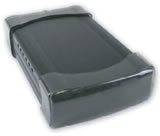
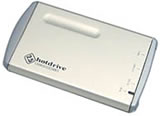 |
Today's Best Choice - Do It YourselfIf you've upgraded a desktop or laptop hard drive, then buy an external case to put the old hard drive to use. Assembling a bare hard drive and an external case only requires a screwdriver and 10 minutes to assemble everything. The external enclosures come with USB cables and the notebook drives may come with a carrying case. I own the Rosewill RX353-S (3.5" SATA drive, eSATA/USB), AMS VENUS DS-2316CBK (3.5" IDE drive, USB), and the BYTECC HD-201U2 (2.5" IDE drive, USB) and couldn't be happier. The Rosewill came with a PCI add-in card for an external eSATA port. My backups went from 800MB/minute with USB 2.0 to 2,400MB/minute with eSATA. Buy a desktop 3.5 hard drive case for $25-$55. Buy a notebook 2.5 hard drive case for $15-$20. |
Uses
An external hard drive is a convenient way to backup an existing hard drive, quickly add additional hard drive space, or move large files from one computer to another.
Backup Software
External hard drives used to backup other hard drives and always came with backup software. Music, videos, and digital photos are filling up the main hard drives and external hard drives are now being used to supplement the main hard drives. That's why backup software is usually sold separately. At least you can buy better software than the watered down version that came with the hard drive.
Change the Drive Letters in Windows
See the change the drive letter section to prevent the external hard drive from changing drive letters when you add and subtract internal hard drives, USB flash drives, or memory card readers. The backup software won't get confused if it always backs up to the same drive letter.
USB, Firewire and eSATA Interfaces
USB 2.0 is found on PCs and Macs. Firewire can be found on both, but is more common on Macs. USB and Firewire drives run slower than internal hard drives. This is because the CPU allows itself to be interrupted more often when it talks to things connected via USB and Firewire than it does when it talks to an internal hard drives.
eSATA (external Serial Advanced Technology Attachment) is the next big promise for data transfers. eSATA transfers data just as fast as internal SATA making it the fastest interface possible for external hard drives. The computer needs to have an eSATA port (plug) in the back of the computer. An eSATA add-in card starts at $25. I was getting around 800MB/minute using Retrospect backup software and a Firewire 400 connection. I'm now getting 2,400MB/minute with eSATA using the same computer and same backup software. The added speed is nice for ad-hoc backups or restoring a hard drive, but it doesn't matter for middle of the night backups.
Testing the Hard Drive
This sounds stupid, but it happened to me. The external hard drive failed to work on the new computer when I tried to transfer the data files from the old computer to the new computer. My external hard drive has a USB and Firewire connection. I backed up the hard drive using the Firewire connection. Firewire (400Mbps) is faster in real life than USB 2.0 (480Mbps). I tried to copy the data files to the new computer with a USB connection. For some unknown reason, the new computer couldn't see the external drive. When I plugged it back into the old computer with the Firewire cable, the drive was unrecognizable and I had to reformat the external drive. What a pain. If you have access to another computer, test to see if the external hard drive will work on another computer. Even if you never mix and match USB and Firewire, it may be worth a few minutes of your time. This discovery lead me to buy a new external hard drive.